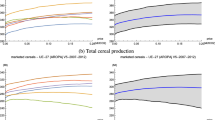Abstract
The importance of greenhouse gas (GHG) emissions related to agriculture is gaining momentum in the climate change policy debate, as evidenced by the European Effort Sharing Decision. Food production is important to economic sustainability in many regions and therefore GHG mitigation in agriculture will have notable macroeconomic implications. A theoretically consistent and tractable framework capturing the link between GHG abatement in primary food production and the wider economy is essential to GHG mitigation strategy development in such regions. Computable general equilibrium (CGE) models provide a straightforward approach to compare the economic and environmental impacts of price/quantity-type policy instruments to meet emission abatement obligations. However, capturing changes to emission intensity associated with agriculture is not nearly as developed in the CGE literature, which has focused on the energy sector. This paper considers alternative approaches to modelling abatement technology in a CGE framework, and illustrates an approach that utilizes standard models available to explore strategic implications of local–regional abatement options. The case study considered is Northern Ireland, a small regional economy with a relatively large proportion of economic activity related to the food supply chain.

Similar content being viewed by others
References
Alexeeva-Talebi V, Bohringer C, Loschel A, Voigt S (2012) The value-added of sectoral disaggregation: implications on competitive consequences of climate change policies. Energy Econ 34:S127–S142. doi:10.1016/j.eneco.2012.10.001
Böhringer C (1998) The synthesis of bottom-up and top-down in energy policy modeling. Energy Econ 20(3):233–248. doi:10.1016/s0140-9883(97)00015-7
Böhringer C, Loschel A (2006) Promoting renewable energy in Europe: A hybrid computable general equilibrium approach. Energy J 27:135–150
Böhringer C, Rutherford TF (2008a) Combining bottom-up and top-down. Energy Econ 30(2):574–596. doi:10.1016/j.eneco.2007.03.004
Böhringer C, Rutherford TF (2008b) Combining top-down and bottom-up in energy policy analysis a decomposition approach. Center for European Economic Research, Mannheim
Böhringer C, Rutherford TF (2009) Integrated assessment of energy policies: decomposing top-down and bottom-up. J Econ Dyn Control 33(9):1648–1661
Burniaux JM, Truong TP (2002) GTAP-E: an energy-environmental version of the GTAP model. GTAP Technical Papers:18
Caron J (2012) Estimating carbon leakage and the efficiency of border adjustments in general equilibrium—Does sectoral aggregation matter? Energy Econ 34:S111–S126. doi:10.1016/j.eneco.2012.08.015
Cross-Departmental Working Group on Greenhouse Gas Emissions (2011) Greenhouse Gas Emissions Reduction Action Plan. Northern Ireland
European Commission (2012) Effort Sharing Decision. http://ec.europa.eu/clima/policies/effort/index_en.htm. Accessed 24/10/2012 2012
Gohin A (2005) The specification of price and income elasticities in computable general equilibrium models: an application of latent separability. Econ Model 22(5):905–925. doi:10.1016/j.econmod.2005.06.005
Gohin A, Moschini G (2006) Evaluating the market and welfare impacts of agricultural policies in developed countries: comparison of partial and general equilibrium measures. Rev Agric Econ 28(2):195–211. doi:10.1111/j.1467-9353.2006.00281.x
Lofgren H, Harris RL, Robinson S (2002) A standard computable general equilibrium (CGE) model in GAMS. International Food Policy Research Institute, Washington, D.C
Minihan ES, Wu Z (2011) A social accounting matrix suitable for agricultural and environmental policy analysis in Northern Ireland. Agri-food and Biosciences Institute
National Atmospheric Emissions Inventory (2012) Emission of the basket of 6 Kyoto GHGs according to Devolved Administration
Author information
Authors and Affiliations
Corresponding author
Rights and permissions
About this article
Cite this article
Minihan, E.S., Wu, Z. Capturing the macroeconomic impact of technology-based greenhouse gas mitigation in agriculture: a computable general equilibrium approach. Oper Res Int J 14, 189–203 (2014). https://doi.org/10.1007/s12351-014-0157-6
Received:
Revised:
Accepted:
Published:
Issue Date:
DOI: https://doi.org/10.1007/s12351-014-0157-6




